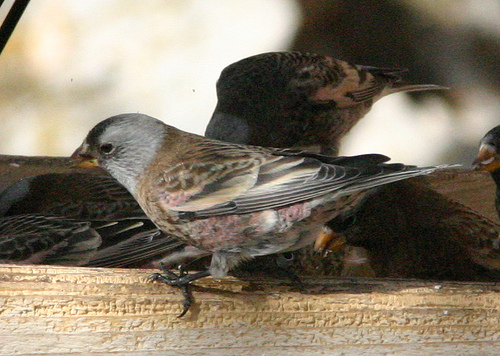Rosy Finchophilia
|
Administrator
|
This post was updated on .
Rosy Finchophilia!
I’m a firm believer in the value of attaining my RDA, BirdChaser’s “Recommended Daily Allowance” of 20 bird species. Even though we spend most of the year on a lake in South Florida, it sometimes takes some effort to see 20 species on our usual 2-3 mile morning walk around our subdivision. The urbanized environment causes some bird species to absolutely avoid our neighborhood. Many others adapt to new resources created along the edges of the developed areas. A hardy few, mostly exotics, exploit and even depend on the greatly modified terrain of houses, lawns, imported palm trees and concrete roadways. Some mornings we decide not to get aerobic, and venture about a quarter of a mile away from our development and into our birding “patch” of protected and recovering Everglades. Here, we meet the bird species that shun civilization: Savannah, Swamp and Grasshopper Sparrows, thrashers, towhees, harriers, yellowthroats and Prairie Warblers… As winter approaches, even exceeding my bird RDA does not seem enough to restore my balance with nature. Now into the middle of my eighth decade of life, I am aware that a peculiar affliction has taken its hold on me. My condition was diagnosed over 10 years ago, not by a medical doctor, but by Hart Schwarz, a respected US Forest Service biologist. For this ailment, there is temporary relief, but no cure. “Finchophilia,” he proclaimed in a note to the birding community . This past November, after Mary Lou and I had a delightful visit with our five Texas Panhandle grandchildren and their parents, we drove 4 1/2 hours west on I-40 into New Mexico, arriving at the Cedar Crest exit at about 11 AM. Since we moved away from The Land Of Enchantment in 2004, some changes were evident. Aside from the proliferation of strip malls along NM-14, we saw that Pinyon Pines had been seriously decimated by the triple attack of drought, borers and disease. Some woodlands at the 6500-7000 foot level seem to have been transformed from pinyon-juniper to Siberian elm-juniper and/or Russian Olive-juniper. As we climbed the road to Sandia Crest, we saw pines, fir and even spruce trees similarly stressed and killed. Patches of snow still covered shady areas and ice coated sheltered bends in the road as we ascended 13 miles to the top. The rosy-finch feeders at Sandia Crest House were our objective. We arrived there at 11:30, and within 5 minutes a flock of about 50 Rosies descended for lunch. All three species were present. Black Rosy-Finches predominated, and I identified only one Brown-capped Rosy-Finch. We saw only one Interior (Hepburn’s) race among the 5-8 Gray-crowned species in the flock. We enjoyed green chile cheeseburgers and the company of about a dozen birders who visited during the two days we spent there. I got so taken up with interpreting the rosy-finch species to visitors that I took very few photographs! I thought I missed a shot of the Brown-capped species, but the lone bird turned up in two of my photos. All three species of rosy-finch swarmed like bees at the lower feeder. If you click on and then select the largest size, you will see the Brown-capped bird on the right side of the feeder. Note its bright pink undersides and lack of white on hindcrown:  This Black Rosy-Finch, at the deck feeder, was in excellent plumage. Note the yellow bill– it will turn black with the approach of breeding season:  Here, on the left, a Coastal (Hepburn’s or gray-cheeked) and an Interior race Gray-crowned Rosy-Finch feed on the surface of the Crest House deck with two Black Rosies:  Hepburn’s race of Gray-crowned Rosy-Finch (Leucosticte tephrocotis littoralis) has become more common on Sandia Crest the past two years:  A Red-breasted Nuthatch provided some comic relief as we waited for the rosy-finches to return (Click on photo for more views):  Like the nuthatches, the Mountain Chickadees would grab a seed and fly off (Click on photo to see crown pattern):  At lower elevations along the road to Sandia Crest, we encountered three races of the Dark-eyed Junco. Gray-headed Juncos predominated in the spruce forest:  There were many Pink-sided Dark-eyed Juncos at the Cienega Canyon Picnic Area, but my best capture was this one, at the Rio Grande Nature Center State Park in Albuquerque:  I only obtained one photo of the Oregon race of Dark-eyed Junco:  We encountered several Townsend’s Solitaires between 7000 and 8000 feet elevation. This one was quite cooperative as it foraged on the ground (Click for additional views):  Mammals seen in the Sandia Mountains included this rabbit-eared and skunk-tailed Abert’s Squirrel (Click for additional view)…  …a Chipmunk… 
…and a Rock Squirrel: 
Ken Schneider
Web site: http://www.rosyfinch.com Blog: http://rosy-finch.blogspot.com Photos: http://www.flickr.com/photos/rosyfinch/ |
«
Return to Sandia Crest Birding FORUM
|
1 view|%1 views
| Free forum by Nabble | Edit this page |

